Menus
- 800cc naked bikes in a comparison test
- MV Agusta Brutale 800 with brutal load changes
- Yamaha MT-09 reacts directly, almost harshly
- Kawasaki Z 800 slightly delayed on the gas
- Suzuki GSR 750 can accelerate Z 800 to 200 km / h
- MV Agusta is sensitive to bumps
- GSR 750 is not easy to get out of the suspension
- Dunlop Roadsmart II for MT-09
- Yamaha MT-09 is the cheapest motorcycle in the test
- Performance measurement
- Data and measured values
- MOTORCYCLE test results
- MOTORCYCLE scoring
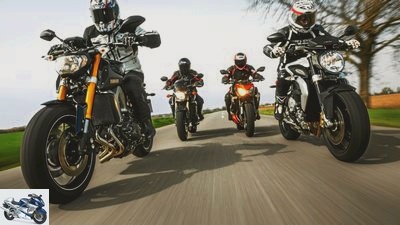
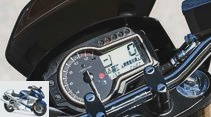
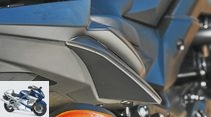
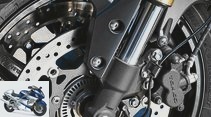
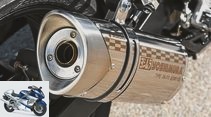
31 photos
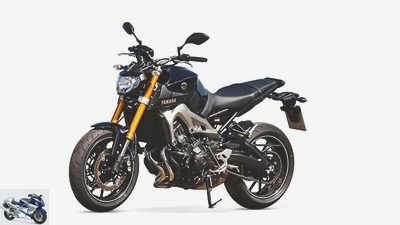
1/31
Winner price-performance ratio Yamaha MT-09: Most points and the cheapest price, that can only give the best rating.
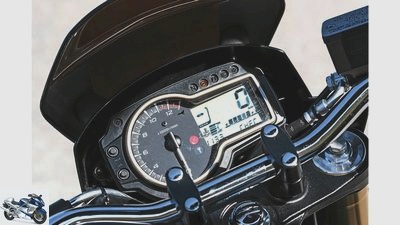
2/31
The analog tachometer is just as easy to read as the large digital speedometer.
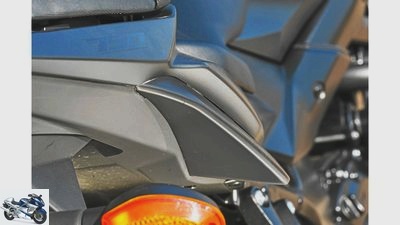
3/31
These side wings effectively prevent the motorcycle and driver from being sucked in by the rear wheel when driving in the rain.
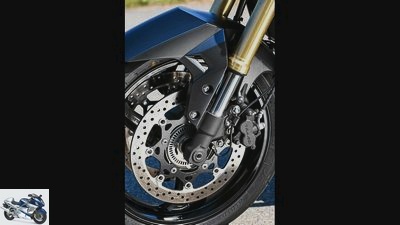
4/31
One of the weak points of the test GSR was the brake. That was more due to the pads than to the double-piston floating calipers.
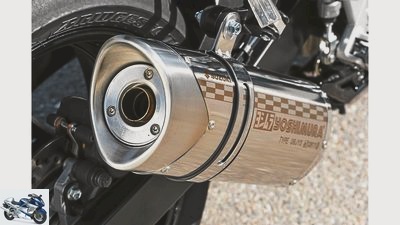
5/31
Costs extra: beautifully finished Yoshimura exhaust system. As with the Z 800, its timbre is more on the darker side.
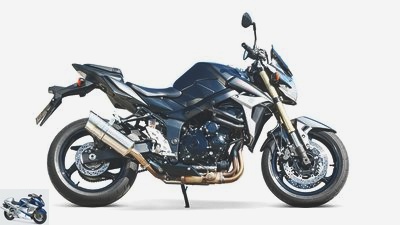
6/31
Steel bridge frame, steel swing arm and a motor derived from the GSX-R 750 – these main components form the core of the GSR.
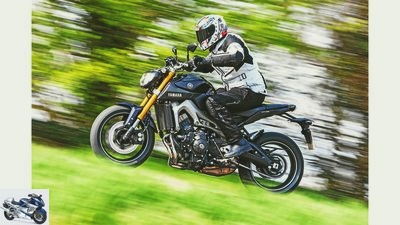
7/31
Yamaha MT-09.
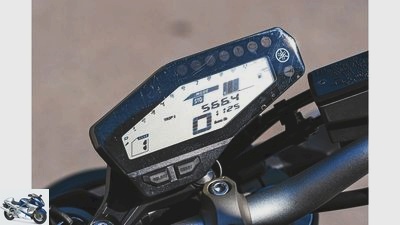
8/31
It’s good that you don’t have to run the three-cylinder MT-09 accurately. The rest of the information is easier to see.
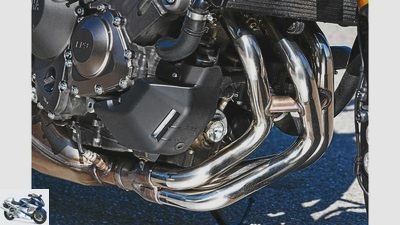
9/31
The Yamaha manifold system also has the aesthetic qualities of a successful metal sculpture.
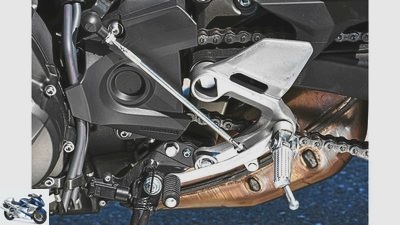
10/31
Footrest holders and levers made of light metal with their smooth surfaces contribute to the high-quality appearance of the MT-09.
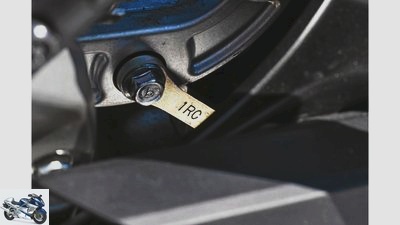
11/31
You have to look deeply to discover this profane pull rod for the rear suspension, punched from sheet steel.
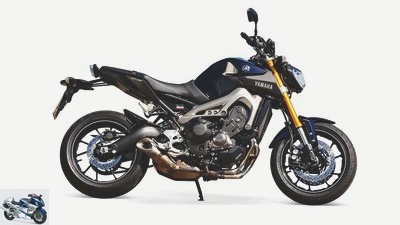
12/31
The Yamaha three-cylinder is also very compact and is surrounded by the cast aluminum frame, but still reasonably accessible for screwdrivers.
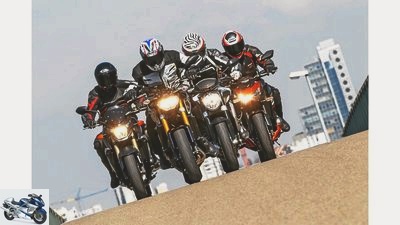
13/31
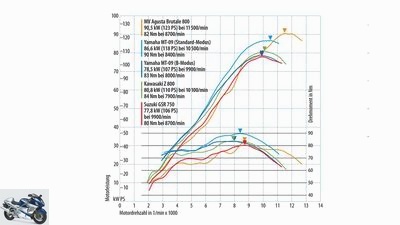
14/31
Performance measurement.
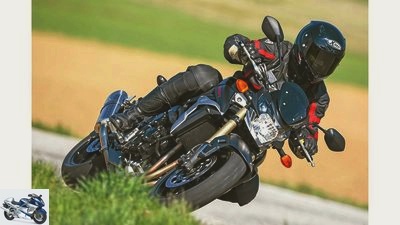
15/31
Suzuki GSR 750.
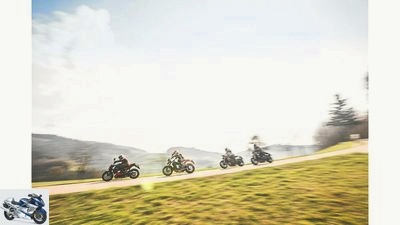
16/31
The early spring made for fantastic weather – even at high altitudes where there was still snow in March last year.
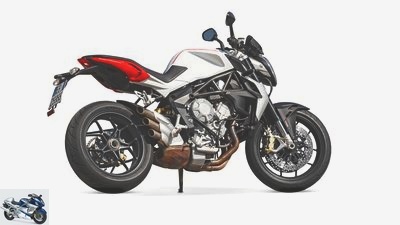
17/31
Compact, easy-to-turn three-cylinder, lightweight chassis made of aluminum parts and tubular steel structure.
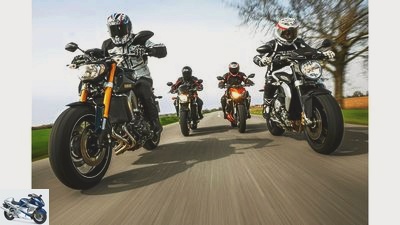
18/31
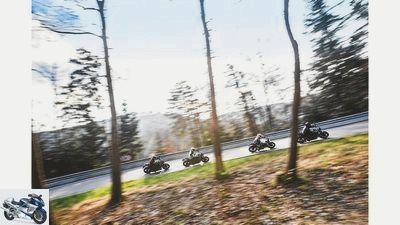
19/31
The test team curled through the Black Forest from valley to valley. Pure enjoyment with the four naked bikes.
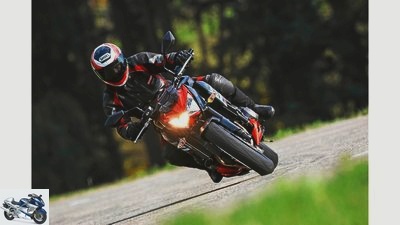
20/31
Kawasaki Z 800.

21/31
Although the tachometer is located in the center of the display, it is not easy to read from behind when the light is on.
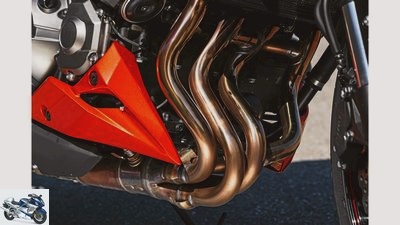
22/31
The sweeping elbow routing and the polishing of the pipes make the Kawa’s exhaust system an eye-catcher.
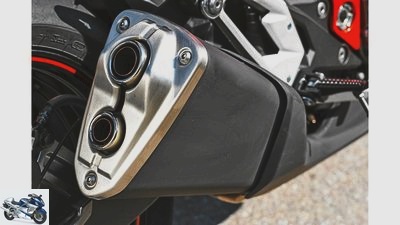
23/31
The silencer is a powerful part, but it makes the Kawa four-cylinder sound nice and dark.
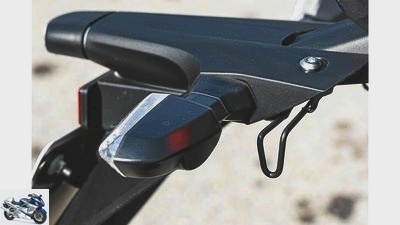
24/31
It’s nice that someone is still thinking about everyday operations and installing small wire loops for lashing straps.
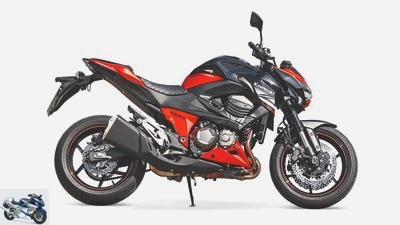
25/31
The styling of the Z 800 is edgy and modern, but there is a traditionally built steel frame under the trim.
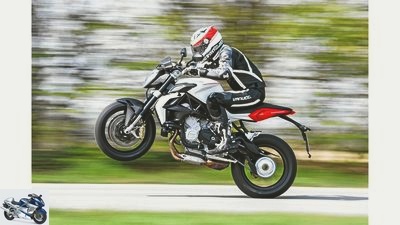
26/31
MV Agusta Brutale 800.
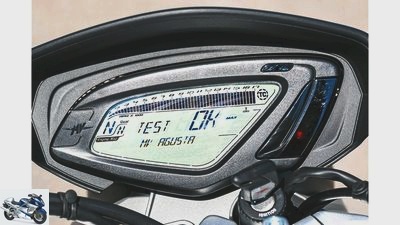
27/31
If there is something in the middle class on the MV, it is the instrument cluster, which, as is customary in this class, does without colored displays.
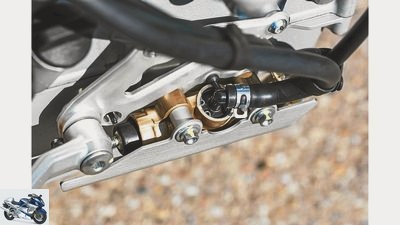
28/31
Just one example of the solid workmanship of the MV: rear brake pump behind a brushed aluminum cover.
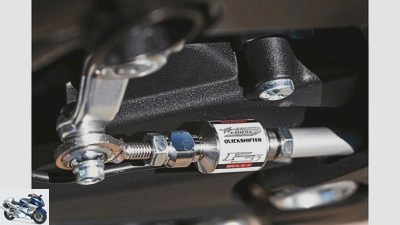
29/31
The shift assistant, which is standard on ABS models, does not harmonize perfectly with the long shift travel.
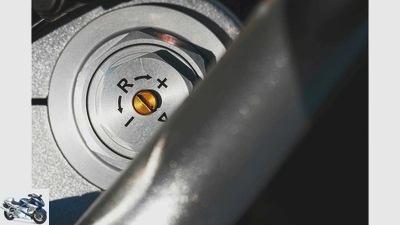
30/31
The fork of the MV can be adjusted in preload and rebound damping, the shock absorber also in compression.
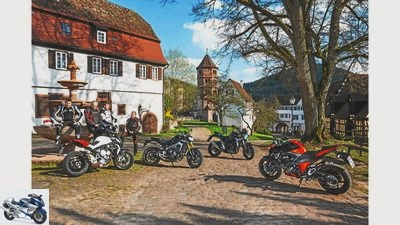
31/31
Kawasaki Z 800, MV Agusta Brutale 800, Suzuki GSR 750 and Yamaha MT-09 in the test
800cc naked bikes in a comparison test
Middle class – under this working title the following story was created. In terms of cubic capacity, the term applies, but what it does not mention is the fact that two of the most exciting and stimulating new releases of recent years are included in this comparison test.
Aren’t the MV Agusta Brutale 800 and Yamaha MT-09 exciting bikes? Exciting because they differ from the established representatives of the class in terms of their character, styling and, thanks to their three-cylinder engines, technology. Exciting, too, because with their front wheel-oriented seating position they promise fun cornering, similar to supermoto. Because they were not created as inexpensive, scaled-down 1000s, but as self-confident, independent new developments. And because they are lighter and younger than those who previously determined the market. Not least for the target group that they address. The Kawasaki Z 800, which has been on the market as the successor to the Z 750 since last year, tries to bridge the gap between the two extremes. In terms of styling, with her angular bodywork, she belongs more to the modern faction, in terms of engines and the design of the chassis, she seeks proximity to the Suzuki GSR 750, the clearly conservative candidate of the comparison.
Buy complete article
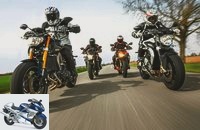
Kawasaki Z 800, MV Agusta Brutale 800, Suzuki GSR 750 and Yamaha MT-09 in the test
800cc naked bikes in a comparison test
MV Agusta Brutale 800 adds a pithy metallic rhythm, while the two four-cylinders sound deep, but pure and very subtle – the Kawasaki Z 800 contradicts its eye-catching paintwork and design. And although the 847 three-cylinder of the Yamaha MT-09 hardly vibrates more than the traditionally designed four-cylinder, these form a culmination of sophistication in the combination of smoothness and sound culture. It is a pity that it is often perceived as too smooth today; many let themselves be beguiled by the exciting, rough voice of the three-cylinder and expect them to provide a more intense driving experience.
MV Agusta Brutale 800 with brutal load changes
The engines with the odd number of cylinders also display somewhat more rustic manners in terms of response and load change behavior. The MV Agusta Brutale 800 in particular jumps on the gas explosively, even in moderate N mode. In the sharper S mode, the MV shone with breathtaking acceleration, but on the other hand also annoyed with brutal load changes. In every mode, the extremely smooth throttle grip and the relatively strong braking torque of the motor ensure abrupt changes between load and push mode, which the driver can only make smoother with very careful work on the throttle grip. From slight movements of the right arm when driving over bumps, the next throttle occurs immediately, so that it takes some time to get used to to conjure up gentle load changes with the MV. It works best when the driver supports the throttle hand on his index and middle fingers, which he places over the brake lever.
The fact that the MV Rivale behaved better than the MV Agusta Brutale 800 in the comparison test in MOTORRAD 1/2014 and that the map used in the Rivale should also be applied to the Brutale models is a bit strange. As a check at the MV authorized dealer Speer in Reutlingen showed, the motorcycle test machine was actually state-of-the-art, but it did not have the same positive effect as the rival. This also affects the function of the shift assistant, which has been installed as standard with every ABS model since 2014. Even with his favorite discipline, quick shifting when accelerating fully, he sometimes caused hard gear changes. When swimming in traffic, you can shift the gears more gently with the clutch and briefly closing the throttle. It is quite possible that the other footrest position and the resulting modified shift linkage will deepen the differences between Rivale and Brutale.
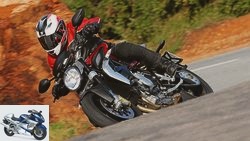
Naked bike
MV Agusta Brutale 800 in the test
The Brutale’s big sister 675
read more
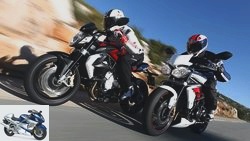
Naked bike
Comparison test: Naked bikes from MV Agusta and Triumph
MV Agusta Brutale 800 and Triumph Street Triple R in comparison test
read more
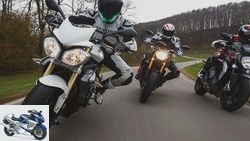
Naked bike
Yamaha MT-09, Triumph Street Triple and MV Agusta Brutale 800 in the test
Three-cylinder nakeds in horsepower comparison
read more
MV Agusta Brutale 800 on markt.motorradonline.de
Yamaha MT-09 reacts directly, almost harshly
The Yamaha MT-09 also reacts directly, almost harshly, to movements of the throttle grip. As with the comparison test in MOTORRAD 23/2013, it is also advisable to drive the current test copy on country roads in B mode. It guarantees smoother transitions than the standard or A mode, but delivers just under 107 instead of 118 hp at the upper end of the engine speed range. A loss that you can usually get over off the highway and the racetrack. If necessary, the full capacity can be reactivated quickly at the push of a button. In the upper two gears, the three-cylinder is also locked in the sharp modes in order to limit the top speed to around 220 km / h.
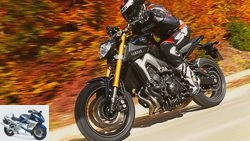
Naked bike
Yamaha MT-09 in the top test
Queuing for the fleet manager
read more
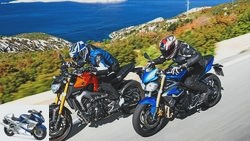
Naked bike
Yamaha MT-09 and Triumph Street Triple tested
Three-cylinder battle in Croatia
read more
Kawasaki Z 800 slightly delayed on the gas
If the three-cylinder accelerates directly, the Kawasaki Z 800 does it with a slight delay. After longer passages with the throttle closed, it even feels as if the throttle valves are tightening for a brief moment. This behavior has already been noticed in other Kawasaki models, for example the ZX-6R 636; apparently it is a peculiarity of Kawasaki four-cylinder engines. Of all four motorcycles, the Suzuki does the best in this discipline; she finds the right balance between too harsh and delayed response.
At least the somewhat impetuous response behavior of the MV Agusta Brutale 800 fits the temperament of its engine perfectly. The MV three-cylinder offers the most power in this field, and it doesn’t even need a fast stretch of the motorway to prove it. Although it only surpasses the values of its competitors at higher engine speeds, they come off the crankshaft so easily that the Brutale likes to lift the front wheel when accelerating on winding country roads. It is by no means a rear-heavy motorcycle, on the contrary. Nevertheless, the front wheel load remains low due to the low overall weight, and the wheelbase is the shortest in the comparison. The MV’s joy in wheelie is also a reason for the not exactly superior acceleration in the lower speed range; the acceleration values up to 200 km / h – achieved in N mode – tell enough about the performance of the MV. And when you pull through in sixth gear, thanks to its short overall translation, it doesn’t take any prisoners anyway.
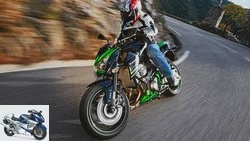
Naked bike
The new mid-range naked bike from Kawasaki
Top test: Kawasaki Z 800
read more
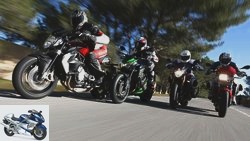
Naked bike
BMW F 800 R, Kawasaki Z 800, MV Agusta Brutale 800 and Yamaha FZ8 in the test
Middle class motorcycles with 800 cc
read more
Buy a used Kawasaki Z 800
Suzuki GSR 750 can accelerate Z 800 to 200 km / h
It is thanks to its low weight and its equally powerful engine that the Yamaha MT-09 outperforms all others in acceleration up to 140 km / h and only has to admit defeat in the upper speed range of the MV. Although the Yamaha three-cylinder offers the most pressure on the crankshaft because of its displacement advantage, it does not turn as high as the smaller MV engine and is therefore geared for longer. The longer gear ratio also helps save fuel. On the other hand, it is the reason why the Yamaha does not quite manage the excellent pulling power of the MV in the last gear.
The two four-cylinder Kawasaki Z 800 and Suzuki GSR 750 are well on the safe side; despite their smaller individual cubic capacity, they are only allowed to rotate about as high as the Yamaha engine. Your performance curves drop in gentle arcs beyond the maximum values. This creates overturn reserves in the event that things get tight when overtaking – just save the upshift and bring the overtaking maneuver to the end with enough power. With less displacement, but larger bore and 4.9 millimeters less stroke, the Suzuki four-cylinder is designed with a significantly shorter stroke than its Kawasaki counterpart. Nevertheless, it stays closer on its heels not only in terms of performance, but also in terms of torque than would correspond to the 7.6 percent displacement advantage of the Kawasaki Z 800. In combination with the 17 kilograms lower weight, the Suzuki GSR 750 can accelerate the Kawasaki up to 200 km / h, but remains a little behind in pulling due to its long transmission. On the other hand, it consumes the least gasoline and can therefore claim to offer the most efficient drive of the comparison in the combination of all engine-relevant ratings.
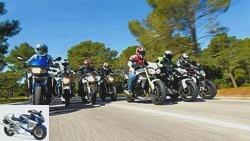
Naked bike
Aprilia Shiver 750 ABS, BMW F 800 R, MV Agusta Brutale 800, Triumph Street Triple, Kawasaki Z 800, Suzuki GSR 740, Yamaha FZ8 in the test
Middle class naked bikes with 2-, 3- and 4-cylinder engines
read more
Suzuki GSR 750 for sale
MV Agusta is sensitive to bumps
If you asked an experienced chassis designer for the best basic recipe for outstanding handiness and playful steering, you would get the following answer: steep steering head angle, short caster, short wheelbase, low weight, wide handlebars, moderate tire width. This recipe corresponds exactly to the concept of the MV Agusta. The Suzuki GSR 750 represents its counterpart. Its steering head is 1.2 degrees flatter, the caster is nine, the wheelbase 70 millimeters shorter, and the weight is 24 kilograms higher. The handlebar width is roughly the same, the tire dimensions are identical.
Anyone who drives the two in direct comparison will find the theory confirmed in practice: the MV Agusta Brutale 800 actually turns more easily, swings more nimbly through changing curves of all kinds. However, this does not mean that this is an advantage in all situations. Because at the same time, the Italian reacts more sensitively to bumps and load changes, which in combination with the already described hard throttle response demands a lot of concentration and coordination of the driver. The fact that he has to keep his knees tight so as not to slide back and forth on the smooth bench when taking off the gas or accelerating doesn’t help either. If you get the hang of it after a while and move the MV with a light hand, you can convert your razor-sharp steering behavior into a very sporty pace.
GSR 750 is not easy to get out of the suspension
The Suzuki GSR 750 cannot easily be disturbed by all sorts of malfunctions, is always safe and remains accurate. Because the contour and carcass of its somewhat old-fashioned Bridgestone BT 016 “EE” initial tires match it perfectly, it retains neutral steering behavior down to deep lean angles. That instills confidence in their drivers. If it weren’t for the tank that is a little too wide and the handlebar ends that are bent upwards, the ergonomics would also contribute to the harmony of the overall package.
Fast bends and complex combinations of bends are most likely to reveal a slight weakness in the chassis of the Kawasaki Z 800 – it lacks a small but important aspect of steering precision. The Z 800 is heavy, feels that way, shows a pronounced righting moment when braking in an inclined position and always seems to float a little on its front tire when cornering. Since the bigger sister Z 1000 behaved similarly with the series tires and suddenly much better with other tires, the assumption is that the 800 series also suffers from its series tires here. It has also been observed for years that Kawasaki developers prefer tires for original equipment that are optimized for comfort, stable straight-line stability and low kickback tendency than for high steering precision and homogeneous steering behavior. Unfortunately, the series tires of the Kawasaki cannot quite keep up with the others in terms of grip either.

Naked bike
Aprilia Shiver 750 ABS, BMW F 800 R, MV Agusta Brutale 800, Triumph Street Triple, Kawasaki Z 800, Suzuki GSR 740, Yamaha FZ8 in the test
Middle class naked bikes with 2-, 3- and 4-cylinder engines
read more
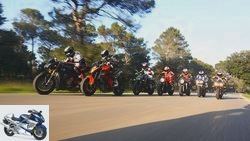
Naked bike
7 power naked bikes in a comparison test
Every man for himself
read more

Naked bike
Yamaha MT-09, Triumph Street Triple and MV Agusta Brutale 800 in the test
Three-cylinder nakeds in horsepower comparison
read more
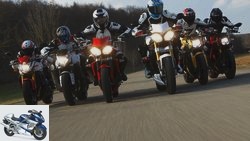
Naked bike
Comparison test: naked bikes big versus small
Naked bikes from Ducati, Triumph and Yamaha put to the test
read more
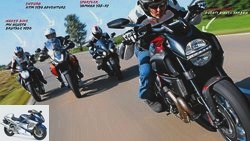
Chopper / cruiser
MV Agusta Brutale 1090, KTM 1190 Adventure, Yamaha YZF-R1 and Ducati Diavel Carbon in the test
Concept comparison of naked bikes, enduro, athletes and cruisers
read more
Dunlop Roadsmart II for MT-09
Slight disadvantages of the standard tires on the Yamaha MT-09 are evident. The editorial team has been driving a long-term test motorcycle of this type for some time, and recently the initial tires were swapped for a Dunlop Roadsmart II. A direct comparison with the test motorcycle was obvious, and it showed that the Yamaha MT-09 with the alternative tires turns in less wobbly and lies more solidly and quietly on the front wheel as the corners continue. And don’t worry: the MT-09 still works easily and carefree in an inclined position – yes, the fuller driving experience means that you tend to let it run a little faster in curves. So the dynamics of the MT-09 doesn’t suffer a bit.
If you place the Yamaha MT-09 next to the Suzuki GSR 750, the exemplary comparison partner in this test in all questions of character and construction philosophy, you will notice the cleverness and modernity with which the Yamaha was constructed. The frame and swing arm are made of cast aluminum and have fine surfaces and a dignified appearance. At the same time, once they have been developed, they are extremely inexpensive to manufacture.
Yamaha MT-09 is the cheapest motorcycle in the test
Suzuki saves more on materials and equipment than through constructive finesse and optimized manufacturing processes. Steel instead of aluminum for the frame, swing arm, handlebars and gear levers, double-piston floating calipers instead of four-piston fixed calipers like the other three motorcycles and the abandonment of polished exhaust manifolds, as used by the Yamaha MT-09 and the Kawasaki Z 800 as eye-catchers, make the Suzuki GSR 750 look very factual. The austerity program is obvious, in addition, it affords a real weakness with its brakes. Toothless and quite stiff at the beginning of every braking process, the GSR rightly takes a heavy point deduction. The floating calipers moved easily on their guides, and removing and braking the linings again and bleeding the hydraulics hardly brought any improvement.
It seems all the more astonishing that it is not the Suzuki GSR 750, but the Yamaha MT-09 with a list price of 7,495 euros that is the cheapest motorcycle in the comparison. Even if you deduct the 910 euros and 90 cents for the Yoshimura rear silencer, the windshield and the tank pad, the Suzuki is still 1095 euros more expensive than the Yamaha according to the official price list. So Suzuki would do well to make the GSR 750 more attractive. It would be a shame if this still very good motorcycle lost any chance on the market. Because until they look at the account balance, many would be more willing to spend 11,590 euros for the MV Agusta Brutale 800 with its extensive equipment and its noble details than 8590 for the Suzuki.
Performance measurement
Power on the crankshaft. Measurements on the Dynojet roller test stand 250, corrected according to 95/1 / EG, maximum possible deviation ± 5%.
There is no substitute for displacement. Everyone knows the saying, and the three-cylinder of the Yamaha MT-09 proves it once more. It uses its capacity advantage by drawing the fullest curve in the diagram in standard mode. Even in the gentle B mode, the curve still lands on the level of the Kawasaki Z 800 and Suzuki GSR 750. In the upper two gears, the engine speed is limited so that the MT-09 only runs about 220 km / h. It is also noticeable how evenly the three engines from Japan develop their power. Not so with the MV engine, which manifests its temperament and impetuosity in the three distinctive upswings that take its curve up to its maximum output. Such levels in combination with the lowest weight and the shortest wheelbase are good for some front wheel lobsters.
Data and measured values
engine
| Kawasaki Z 800 | MV Agusta Brutale 800 | Suzuki GSR 750 | Yamaha MT-09 | |
| design type | Four-cylinder, four-stroke in-line engine | Three-cylinder four-stroke in-line engine | Four-cylinder, four-stroke in-line engine | Three-cylinder four-stroke in-line engine |
| injection | Ø 34 mm | Ø 47 mm | Ø 32 mm | Ø 41 mm |
| coupling | Multi-panes- Oil bath clutch |
Multi-panes- Oil bath clutch |
Multi-panes- Oil bath clutch |
Multi-panes- Oil bath clutch |
| Bore x stroke | 71.0 x 50.9 mm | 79.0 x 54.3 mm | 72.0 x 46.0 mm | 78.0 x 59.1 mm |
| Displacement | 806 cc | 798 cc | 749 cc | 847 cc |
| compression | 11.9: 1 | 13.3: 1 | 12.3: 1 | 11.5: 1 |
| power | 83.0 kW (113 hp) at 10200 rpm |
92.0 kW (125 PS) at 11,600 rpm |
78.0 kW (106 hp) at 10,000 rpm |
84.6 kW (115 PS) at 10,000 rpm |
| Torque | 83 Nm at 8000 rpm | 81 Nm at 8600 rpm | 80 Nm at 9000 rpm | 88 Nm at 8500 rpm |
landing gear
| Kawasaki Z 800 |
MV Agusta Brutale 800 |
Suzuki GSR 750 |
Yamaha MT-09 |
|
| frame | Bridge frame from steel |
Steel tubular frame | Bridge frame from steel |
Bridge frame made of cast aluminum |
| fork | Upside-down- Fork, Ø 41 mm |
Upside-down- Fork, Ø 43 mm |
Upside-down- Fork, Ø 41 mm |
Upside-down- Fork, Ø 41 mm |
| Brakes in front/back | Ø 310/250 mm | Ø 320/220 mm | Ø 310/240 mm | Ø 298/245 mm |
| Assistance systems | SECTION | SECTION, Traction control |
SECTION | SECTION |
| bikes | 3.50 x 17; 5.50 x 17 | 3.50 x 17; 5.50 x 17 | 3.50 x 17; 5.50 x 17 | 3.50 x 17; 5.50 x 17 |
| tires | 120/70 ZR 17; 180/55 ZR 17 | 120/70 ZR 17; 180/55 ZR 17 | 120/70 ZR 17; 180/55 ZR 17 | 120/70 ZR 17; 180/55 ZR 17 |
| Tires | Dunlop D 214 “J” |
Pirelli Diablo Rosso II |
Bridgestone BT 016 “EE” |
Bridgestone S 20 “M” |
measurements and weight
| Kawasaki Z 800 | MV Agusta Brutale 800 | Suzuki GSR 750 |
Yamaha MT-09 | |
| wheelbase | 1445 mm | 1380 mm | 1450 mm | 1440 mm |
| Steering head angle | 66.0 degrees | 66.0 degrees | 64.8 degrees | 65.0 degrees |
| trailing | 98 mm | 95 mm | 104 mm | 103 mm |
| Front / rear suspension travel | 120/137 mm | 125/125 mm | 120/135 mm | 137/130 mm |
| Seat height¹ | 820 mm | 810 mm | 810 mm | 810 mm |
| Weight with a full tank¹ | 231 kg | 190 kg | 214 kg | 192 kg |
| Payload¹ | 180 kg | 174 kg | 186 kg | 173 kg |
| Tank capacity | 17.0 liters | 16.6 liters | 17.5 liters | 14.0 liters |
| Service intervals | 6000 km | 6000 km | 6000 km | 1000 km |
| price | 8,995 euros | 11590 euros | 8590 (9501) ² euros | 7495 euros |
| Additional costs | 180 euros | 275 euros | 190 euros | 170 euros |
MOTORCYCLE readings
| Kawasaki Z 800 | MV Agusta Brutale 800 |
Suzuki GSR 750 | Yamaha MT-09 | |
| Top speed * | 230 km / h | 245 km / h | 225 km / h | 210 km / h |
| acceleration | ||||
| 0-100 km / h | 3.3 sec | 3.5 sec | 3.3 sec | 3.3 sec |
| 0-140 km / h | 5.7 sec | 5.6 sec | 5.7 sec | 5.4 sec |
| 0-200 km / h | 14.0 sec | 10.7 sec | 12.5 sec | 11.5 sec |
| Draft | ||||
| 60-100 km / h | 3.8 sec | 3.1 sec | 4.3 sec | 3.3 sec |
| 100-140 km / h | 4.1 sec | 3.2 sec | 4.2 sec | 4.0 sec |
| 140-180 km / h | 4.8 sec | 3.5 sec | 5.2 sec | 4.4 sec |
| Consumption country road / 100 km | 5.0 liters | 6.1 liters | 4.3 liters | 4.7 liters |
| Reach country road | 340 km | 272 km | 407 km | 298 km |
* Manufacturer information; ¹ MOTORCYCLE measurements; ² incl. Yoshimura exhaust (750 euros), windshield (140 euros) and tank pad (21 euros).
MOTORCYCLE test results
1. Yamaha MT-09
Apart from the hard throttle response and the somewhat wobbly standard tires, the MT-09 does not show any weaknesses. On the contrary, she is usually at the front. Because it is also available for a low price, it rightly wins.
2. Suzuki GSR 750
The Suzuki is the motorcycle for a second or third glance. Unspectacular in appearance and sound, it proves to be a very good motorcycle in many ratings. Brakes with blunt pads were the only weakness of the test machine.
3. Kawasaki Z 800
Their high weight is probably the reason why the powerful and cultivated four-cylinder cannot optimally present itself. Slight reductions in steering behavior are most likely at the expense of the production tires.
4th MV Agusta Brutale 800
A truly fascinating loser: fast, extremely handy, but not that easy to drive due to the impetuous response and the agile chassis. The high price is okay considering the features and workmanship.
MOTORCYCLE scoring
Engine:
| Maximum score |
Kawasaki Z 800 |
MV Agusta Brutal 800 |
Suzuki GSR 750 |
Yamaha MT-09 |
|
| Draft | 40 | 30th | 37 | 28 | 33 |
| acceleration | 40 | 29 | 30th | 30th | 31 |
| Top speed | 30th | 19th | 19th | 18th | 15th |
| Engine characteristics | 30th | 19th | 23 | 22nd | 25th |
| Responsiveness | 20th | 12th | 11 | 15th | 14th |
| Load change | 20th | 14th | 12th | 15th | 13 |
| Smoothness | 20th | 15th | 12th | 15th | 14th |
| coupling | 10 | 8th | 7th | 8th | 7th |
| circuit | 20th | 13 | 10 | 13 | 11 |
| Gear ratio | 10 | 9 | 9 | 8th | 9 |
| Start | 10 | 8th | 8th | 8th | 9 |
| total | 250 | 174 | 178 | 180 | 181 |
A case for the Yamaha MT-09, which the Suzuki GSR 750 remains closely on its heels. The inconspicuous GSR mainly scores in the “soft” criteria such as responsiveness and smoothness. It is also the only one in which first gear can be engaged silently. In the driving dynamics disciplines, the three-cylinder engines are a force.
Winner engine: Yamaha MT-09
Landing gear:
| maximum number of points | Kawasaki Z 800 | MV Agusta Brutal 800 |
Suzuki GSR 750 |
Yamaha MT-09 |
|
| Handiness | 40 | 28 | 34 | 28 | 31 |
| Stability in turns | 40 | 26th | 25th | 27 | 25th |
| Steering behavior | 40 | 25th | 28 | 28 | 26th |
| feedback | 10 | 6th | 7th | 5 | 7th |
| Inclined position | 20th | 17th | 19th | 17th | 17th |
| Straight-line stability | 20th | 14th | 11 | 14th | 13 |
| Suspension tuning in front | 20th | 14th | 13 | 12th | 12th |
| Chassis set-up at the rear | 20th | 13 | 11 | 12th | 12th |
| Adjustment options undercarriage | 10 | 3 | 6th | 2 | 4th |
| Suspension comfort | 10 | 5 | 4th | 5 | 7th |
| Driving behavior in the passenger | 20th | 14th | 10 | 13 | 12th |
| total | 250 | 165 | 168 | 163 | 166 |
Despite the evenness of the Yamaha MT-09, the MV Agusta Brutale 800 wins this chapter. The fact that the two three-cylinder units are ahead in terms of handiness, whereas the Kawasaki and Suzuki are more in the stability criteria, fits the character of the motorcycles. Be careful when driving fast with the MV: The heels of motorway bridges do not leave you unmoved.
Chassis winner: MV Brutale 800
Everyday life:
| maximum number of points |
Kawasaki Z 800 | MV Agusta Brutal 800 |
Suzuki GSR 750 |
Yamaha MT-09 |
|
| Ergonomics driver | 40 | 27 | 29 | 27 | 30th |
| Ergonomics pillion | 20th | 6th | 9 | 10 | 6th |
| Windbreak | 20th | 1 | 1 | 3 | 0 |
| view | 20th | 10 | 11 | 13 | 13 |
| light | 20th | 15th | 14th | 14th | 14th |
| Furnishing | 30th | 14th | 12th | 13 | 15th |
| Handling / maintenance | 30th | 16 | 17th | 16 | 17th |
| Luggage storage | 10 | 2 | 1 | 1 | 1 |
| Payload | 10 | 4th | 3 | 5 | 3 |
| Range | 30th | 20th | 15th | 26th | 17th |
| processing | 20th | 14th | 15th | 13 | 15th |
| total | 250 | 129 | 127 | 141 | 131 |
Everyday life sounds banal, but this chapter contains many criteria that determine how comfortable we feel on a motorcycle. So this stage win for the Suzuki GSR 750 is worth a lot. Above all, note the enormous range, which is due to the extremely low consumption. The small windshield actually offers noticeable protection when driving fast.
Winner everyday: Suzuki GSR 750
Security:
| Maximum score |
Kawasaki Z 800 |
MV Agusta Brutal 800 |
Suzuki GSR 750 |
Yamaha MT-09 |
|
| Braking effect | 40 | 28 | 30th | 23 | 31 |
| Brake metering | 30th | 24 | 25th | 21st | 26th |
| Braking with a passenger / fading | 20th | 13 | 13 | 11 | 13 |
| Righting moment when braking | 10 | 5 | 7th | 6th | 7th |
| ABS function | 20th | 12th | 14th | 12th | 12th |
| Handlebar slapping | 20th | 15th | 10 | 12th | 12th |
| Ground clearance | 10 | 8th | 7th | 8th | 7th |
| total | 150 | 105 | 106 | 93 | 108 |
It is the brakes that spoil the Suzuki GSR 750’s rating here. The Yamaha MT-09 help them to another stage victory. A compliment for the successful tuning of its ABS goes to the MV Agusta Brutale 800.
Safety winner: Yamaha MT-09
Costs:
| Maximum score |
Kawasaki Z 800 | MV Agusta Brutale 800 | Suzuki GSR 750 | Yamaha MT-09 | |
guarantee
Suzuki GSR 750 and Yamaha MT-09 save head to head. The latter has a minimal head start thanks to the low inspection costs.
Winner cost: Yamaha MT-09
| maximum number of points | Kawasaki Z 800 | MV Agusta Brutale 800 |
Suzuki GSR 750 |
Yamaha MT-09 | |
| Overall rating | 1000 | 627 | 625 | 636 | 646 |
| placement | 3. | 4th. | 2. | 1. | |
| Price-performance note | 1.0 | 1.7 | 2.4 | 1.5 | 1.0 |
Winner price-performance: Yamaha MT-09 – the most points and the cheapest price, that can only give the best rating.
Related articles
-
Comparison test: naked bikes BMW, Ducati, Triumph, Yamaha, Kawasaki
fact 66 pictures fact 1/66 If you want a real all-rounder, the Yamaha FZ8 is the right choice. fact 2/66 No trace of saving: Despite the …
-
Comparison test of naked bikes with three-cylinder engines
fact 50 pictures fact 1/50 This swelling, threatening screeching is not about a squadron, but about the five …
-
Comparative test of naked bikes – reason machines
j.kuenstle.de 39 pictures 1/39 Suzuki B-King: Price 14,490 euros, additional costs around 145 euros. 2/39 Kawasaki Z 1000: Price 11295 …
-
Comparative test of naked bikes 2013
fact 37 pictures fact 1/37 Aprilia Shiver 750 ABS, Triumph Street Triple 675, Suzuki GSR 750, Kawasaki Z800, Yamaha FZ8, MV Agusta Brutale 800 and BMW F …
-
90 hp naked bikes in a comparison test
fact 27 photos fact 1/27 One look at the performance diagram and it becomes clear: Even within the 90 hp middle class, there are worlds between the…
-
Comparison test of mid-range bikes with full fairing
Gargolov 26 pictures Gargolov 1/26 Kawasaki ER-6f: Inexpensive, compact, light and handy – the powerful parallel twin is fun, the chassis is …
-
Comparison test of naked bikes from Japan
Art 15 pictures Art 1/15 Art 2/15 Art 3/15 Art 4/15 Art 5/15 Art 6/15 Art 7/15 Art 8/15 Art 9/15 Art 10/15 …
-
Comparison test of mid-range naked bikes over 100 hp
31 pictures 1/31 Yamaha MT-09 SP, Kawasaki Z 900, Triumph Street Triple R, KTM 790 Duke, Ducati Monster 821 and Suzuki GSX-S 750 …
-
fact 42 pictures fact 1/42 The shadow follows as best it can. The desire to move, the joy of driving, dancing on an incline – that’s what the dynamic …
-
Power Naked Bikes in Comparison – Part 2
31 photos 1/31 BMW S 1000 R, Honda CB 1000 R, Kawasaki Z 1000, Suzuki GSX S 1000 and Yamaha MT 10 in the comparison test….